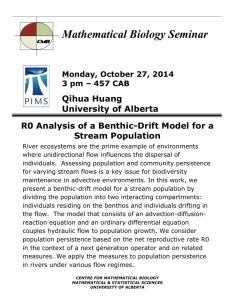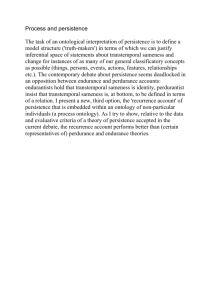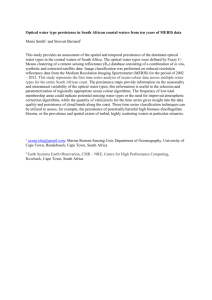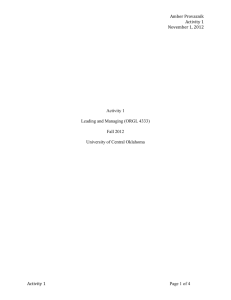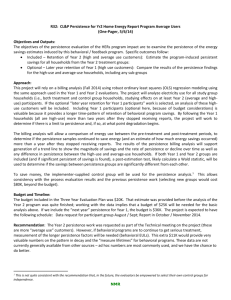Persistence in NICMOS: Results from On-Orbit data.
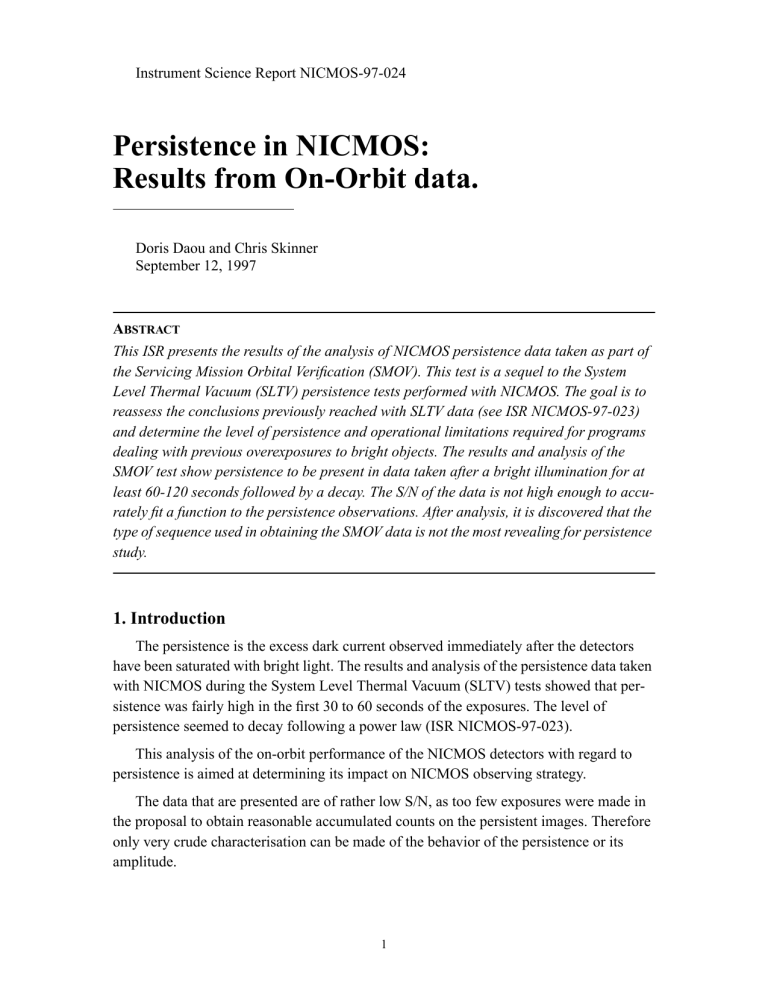
Instrument Science Report NICMOS-97-024
Persistence in NICMOS:
Results from On-Orbit data.
Doris Daou and Chris Skinner
September 12, 1997
A BSTRACT
This ISR presents the results of the analysis of NICMOS persistence data taken as part of the Servicing Mission Orbital Verification (SMOV). This test is a sequel to the System
Level Thermal Vacuum (SLTV) persistence tests performed with NICMOS. The goal is to reassess the conclusions previously reached with SLTV data (see ISR NICMOS-97-023) and determine the level of persistence and operational limitations required for programs dealing with previous overexposures to bright objects. The results and analysis of the
SMOV test show persistence to be present in data taken after a bright illumination for at least 60-120 seconds followed by a decay. The S/N of the data is not high enough to accurately fit a function to the persistence observations. After analysis, it is discovered that the type of sequence used in obtaining the SMOV data is not the most revealing for persistence study.
1. Introduction
The persistence is the excess dark current observed immediately after the detectors have been saturated with bright light. The results and analysis of the persistence data taken with NICMOS during the System Level Thermal Vacuum (SLTV) tests showed that persistence was fairly high in the first 30 to 60 seconds of the exposures. The level of persistence seemed to decay following a power law (ISR NICMOS-97-023).
This analysis of the on-orbit performance of the NICMOS detectors with regard to persistence is aimed at determining its impact on NICMOS observing strategy.
The data that are presented are of rather low S/N, as too few exposures were made in the proposal to obtain reasonable accumulated counts on the persistent images. Therefore only very crude characterisation can be made of the behavior of the persistence or its amplitude.
1
2. Analysis
The data
The plan for the SMOV persistence test consists of overexposing the detectors to a bright object and then taking sets of darks. The level of “excess dark current” is the level of persistence.
The data is obtained in four major stages: 1) a long exposure of 512 seconds where the selected star, Oph S1, is observed with the F160W filter; 2) One dark exposure follows; 3) another long exposure of the star is taken with the same filter (F160W); 4) finally a sequence of 6 sets of darks is obtained with the idea of observing the behavior of persistence through a period of 3072 seconds (6x512seconds).
For each camera, the data is taken using the MULTIACCUM readout mode, the
MIF512 sequence and a total exposure time of 512 seconds with the NSAMP keyword set to 25.
Since the MIF512 sequence is characterized by 9 rapid readouts both at the start and the end of the observation, only 7 readouts are long enough (delta-time ~ 64 seconds) to accumulate pertinent data. The MIF sequence was used in order to obtain low read noise, because the persistent signal was expected to be small. However, all the intermediate reads are single reads, so the advantage of the multiple reads is largely lost! A logarithmic sequence of read times, such as one of the STEP patterns, would have been more useful for determining the behavior of the persistence signal as a function of time.
The Method
In ISR NICMOS-97-023, it was demonstrated that the subtraction of “background” darks helps isolating counts due to actual persistence and eliminating counts resulting from other detector-amplifier phenomena. Therefore background darks are obtained from the reference files database. The choice is made according to camera and readout sequence. These reference files are synthetic darks constructed by the STScI NICMOS group. The persistence observations are recalibrated using CALNICA and “background dark” subtracted.
As mentioned in the previous section, the data is obtained with the MULTIACCUM mode. Since MULTIACCUM readouts are non destructive, the total counts increase with each additional readout. In calculating the level of “left-over” light one expects a decrease in the average count rate from one readout to the next. This decrease will characterize the decaying behavior of the persistence. In order to isolate the counts accumulated exclusively by each readout, previous exposures are subtracted from each, and the remainder
2
plotted with respect to the SAMP time (Figures 1, 4 and 7 respectively for Cameras 1, 2 and 3). The SAMP time is the total exposure time elapsed from the first readout until the present one.
The persistence is determined by calculating the delta-counts and count-rate in the preilluminated area of the darks around the star in a box of dimension 40x50 pixels in which the ratio of the highest pixel over the average is in the order of a few hundreds. Concentrating on this area diminishes the uncertainty level in the persistence introduced by other factors such as amplifier glow and pedestal effect. In fact, computing the average over the entire chip, results in higher measurements suggesting pedestal contamination may be significant. But it is very difficult to estimate how much of the effect seen here is due to the pedestal rather than persistence.
The Results and Discussions
The results of the SMOV persistence test are plotted for all three cameras in two formats: the average delta-count with respect to the SAMP time in figures 1, 4 and 7; and the average count-rate with respect to the SAMP time in figures 2, 5 and 8 respectively for cameras 1, 2 and 3.
The results show the darks to have a relatively high level of counts (count-rate) in the area of overexposure. This symptom persists for almost 120 seconds depending on the camera. It also shows a slow decrease as a characteristic if the persistence. But although the persistence is decaying, it is still visible in all five dark exposures at a lower level of about 0.05-0.1 ADU/sec, and the persistent stellar image is still visible after 3000 seconds as shown in figures 3, 6 and 9 for cameras 1, 2 and 3 respectively.
Although the total counts in an exposure decreases with time since the last autoflush, the count-rate during the first read of an exposure is usually higher than that in the last read of the previous exposure, indicating that the persistence is not as simple as a steadily changing bias with time since autoflush.
3. Conclusions and Recommendations
In this ISR we have demonstrated that persistence is fairly high in the first 60-120 seconds of an exposure. The persistent images are visible as long as 3000 seconds after the initial saturation on a bright source, confirming that persistence is likely to leave image artefacts during programs of observations of bright sources. However, the S/N in the images obtained here is too low to accurately characterize the behavior of the persistent signal.
3
Figure 1: CAMERA 1
20
10
0
0 100 200 300
SAMP TIME (SEC)
400 500
Figure 2: CAMERA 1
1
.75
.5
.25
0
-.25
0 100 200 300
SAMP TIME (SEC)
400 500
4
Figure 3:
CAMERA 1 ALL 6 EXPOSURES CONSECUTIVELY
20
10
0
0 1000 2000
SAMP TIME (SEC)
3000
5
Figure 4: CAMERA 2
20
10
0
0 100 200 300
SAMP TIME (SEC)
400 500
Figure 5: CAMERA 2
1
.75
.5
.25
0
-.25
0 100 200 300
SAMP TIME (SEC)
400 500
6
Figure 6:
CAMERA 2 ALL 6 EXPOSURES CONSECUTIVELY
20
10
0
0 1000 2000
SAMP TIME (SEC)
3000
7
Figure 7: CAMERA 3
20
10
0
0 100 200 300
SAMP TIME (SEC)
400 500
Figure 8: CAMERA 3
1
.75
.5
.25
0
-.25
0 100 200 300
SAMP TIME (SEC)
400 500
8
Figure 9:
CAMERA 3 ALL 6 EXPOSURES CONSECUTIVELY
20
10
0
0 1000 2000
SAMP TIME (SEC)
3000
9

